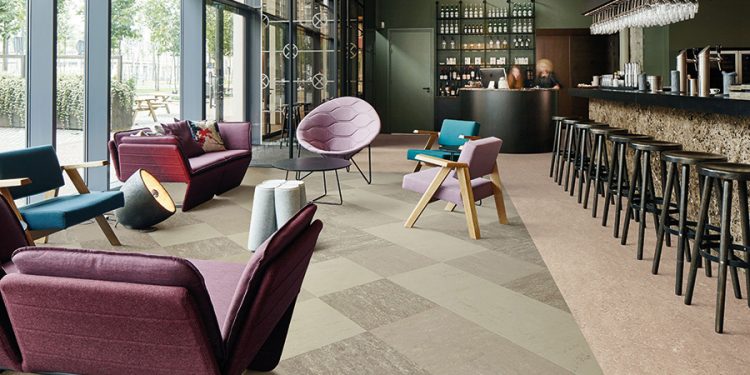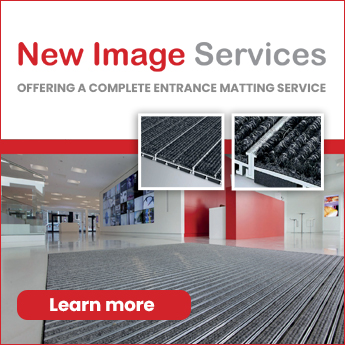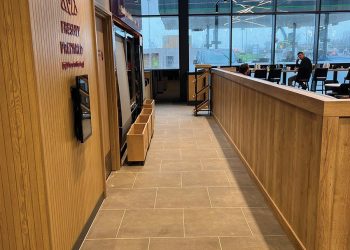INTRODUCING Marmoleum, Forbo Flooring Systems’ own brand of linoleum, renowned across the industry for its durability, sustainability, high quality and innovative design. Here I’ll explore linoleum, looking at how it’s manufactured, its sustainability qualifications and the benefits it can provide to building users and occupants.
Marmoleum is arguably the most sustainable floor covering available on the market right now. Made from 97% natural raw materials, it is the first resilient flooring to achieve official Climate Positive status from cradle to gate, without offsetting. Combine this with the fact that it is truly versatile and available in over 300 designs in both sheet, tile and plank formats, it is a solution that ticks a lot of boxes when it comes to choosing floor coverings.
Who invented linoleum and what are its raw materials?
Linoleum’s origin dates back to the 19th century, where it was developed by Frederick Walton. While technological innovations have advanced since then, only a handful of people can master the art of making Forbo’s Marmoleum. This is something that Forbo prides itself on, with in-house experts able to accurately determine the right mixture of ingredients, maintain the optimum time for the raw materials to settle and apply the correct temperature and pressure to create this innovative flooring solution.
Part of Marmoleum’s appeal is the materials used to make it; Marmoleum contains 97% natural raw materials, including pine rosin, linseed oil, wood flour, limestone, organic pigments and a jute mesh backing. In addition, Marmoleum is made from 61% renewable sources and contains 43% recycled and reused materials, all of which have led to Marmoleum winning an array of environmental certificates, such as the Nordic Swan, Blue Angel and Nature Plus certifications.
How is Marmoleum made?
The first stage sees linseed oil and pine rosin being added to large boilers and mixed together to create linoleum cement, whereby the linseed oil absorbs oxygen, and the rosin creates a flexible binder, called linoleum cement. This linoleum cement is then stored in containers for 10 to 14 days in a heated storage room, until it reaches the right consistency and elasticity. Wood flour is then added to create a firm, dry mixture.
Following this, finely ground limestone is added along with colour pigments to create a firm homogeneous mass in preparation for the final mixing stage. This mixture is shredded in various stages as it is being transported to storage lofts in preparation. These granules form beds of different colour linoleum granules, with each bed producing approximately 15 rolls of linoleum. The linoleum granules are then transported to the final mixing process where they are calendared into a one-metre-wide sheet, which is then cut into two-metre-wide slabs using a special knife.
These slabs are then flipped over ready to be combined with the jute material – the backing for the finished flooring. The jute and the linoleum slabs then meet in front of a large calendar, with two cylinders of different temperatures and speed pressing the two layers together to the correct thickness.
The sheet is then transported to a drying chamber, which is right behind the calendar, and it remains there for 14 to 20 days before receiving its top layer finish. A specially developed finish is applied in two layers, a primer and a finishing layer, both of which are UV cured, providing the sheet with lifelong protection.
Before it is packaged up and distributed to customers around the globe, every linear metre is inspected thoroughly to ensure it meets the quality required.
How does Marmoleum perform, once installed?
Alongside its environmental benefits, durability is another clear quality that Marmoleum has to offer. Developed specially for Marmoleum, Topshield pro is Forbo’s high performance UV-finish, which is applied to all Marmoleum coverings, and has been proven to provide three times better protection than its predecessor. What’s more, with a new application process the finish is tougher than ever before, making the surface even less susceptible to dirt build-up; and with no initial polymer application, it makes for a “ready to use floor”.
Topshield pro also helps prevent staining, scuffing and scratching for long-lasting appearance retention and makes it easy to clean and maintain. In the long term, this can result in less material wastage when replacing damaged flooring and lower maintenance costs, bringing with it a much lower cost of ownership.
What about its sustainability criteria?
With the UK Government having set an aim to be at Net Zero by 2050 and construction accounting for 40% of carbon emissions yearly, finding options that can reduce the environmental impact of construction is paramount. With this in mind, many contractors are now turning to materials that can help reduce the impact their projects have on the environment, such as Marmoleum.
This is because Marmoleum has achieved official climate positive status from cradle to gate, without offsetting. In fact, every square meter of Marmoleum 2.5mm sheet now contributes to removing an additional 446 grams of carbon dioxide from the air, going beyond net-zero emissions to positively impact the climate, from cradle to gate.
A key factor that sets Marmoleum apart from other solutions is Forbo’s commitment to holistic sustainability. Its Marmoleum sheet range has been designed to ensure that every stage of its product life cycle has a positive impact on the environment. This includes the careful consideration of factors such as raw material extraction, manufacturing processes, energy consumption, transportation, installation, in situ cleaning and maintenance, as well as end of life options.
A great example of this is Forbo’s Marmoleum Cocoa collection, manufactured from 97% natural raw materials and 43% recycled content, with the latter including upcycled cocoa husk waste from the chocolate manufacturing industry. What’s more, of this recycled content, 33% is made up of industry and installation waste, and now, for the first time in Forbo’s history, End of Life (EOL) recycled Marmoleum content. This milestone further highlights the sustainability of the collection.
Marmoleum is good for the environment, but is it good for people too?
Thanks to the natural raw materials used to make it, Marmoleum is naturally bacteriostatic and has been independently proven to inhibit the growth and spread of infections like MRSA, Norovirus and more. Not only this but Marmoleum has been awarded the prestigious Allergy UK Seal of Approval, meaning it positively impacts the lives of those suffering with allergies.
It boasts 30 times lower TVOCs (Total Volatile Organic Compounds) than the European norm and is independently proven to contribute to a healthier indoor environment. Marmoleum also contains no phthalates, plasticisers or mineral oils which are shown to have negative impacts on a user’s health. The absence of these potentially toxic materials is yet another benefit to those using the flooring and can help reduce unnecessary contact with harmful substances.
When it comes to reducing noise pollution, another consideration for ensuring a welcoming and healthy indoor environment for building occupants, Marmoleum ticks the box once again, with the acoustic range providing an impact sound reduction of 18 dB.
What designs is Marmoleum available in?
You’re sure to be spoilt for choice, as Marmoleum is available in over 300 colourways and 12 different structures, as well as in sheet, tile and plank formats. The sheet format allows for intricate designs to be cut, whilst the plank and tile formats reflect the ever-growing trend of modularity. The modular offer provides a distinctive format that allows contractors to easily combine and connect various shapes, sizes and colours of tiles to create a completely unique flooring design.
Additionally, an Aquajet water cutting technology can make it possible to recreate the most intricate of designs, logos, texts or pieces of art using Marmoleum.
The latest addition to Forbo’s Marmoleum collection is the refreshed Marmoleum Cocoa range, with a variety of new shades enabling the creation of beautiful, contemporary interiors, whilst simultaneously contributing to the circularity of a building. Featuring 10 soft yet highly contemporary colourways, of which six are completely new to the range. The new colourways include the refined green-grey Eucalyptus, the coppery Salted Caramel, and the muted blue Indigo Milk – plus three more: Milk Chocolate, Nori and Meringue. These shades combined with the cocoa husks included within the manufacturing process has resulted in a modern flooring solution, which meets the interior design trends and sustainable building requirements of today and the future.
Forbo’s Marmoleum solutions range from this to the more traditional and simplistic Marmoleum Solid, which features a more natural aesthetic, or Marmoleum Marbled which uses simple colours with a marbled pattern to create contemporary spaces.
From Marmoleum Cocoa to Marmoleum Marbled, there are designs to suit all tastes.
Where can you install Marmoleum?
With such a wide range of colourways and benefits, Marmoleum can be used in almost any environment. With antibacterial properties, durability, ease of cleaning and being as sustainable as they come, Marmoleum is a truly versatile offering.
These benefits make it perfect for almost any environment, including high traffic areas like those found in education or retail buildings, where interior products that are both easy to maintain and durable are required. Alternatively, with antibacterial properties, Marmoleum is also ideal for installation within healthcare facilities where a solution that can minimise the spread of infections is vital. Not only this, but a wide range of Marmoleum colourways have been assessed and accredited for use in dementia friendly environments by the University of Stirling’s Dementia Services Development Centre (DSDC). This means they can be used across care facilities for those with dementia, without confusing residents, whilst still providing all the sustainability and durability benefits of Marmoleum. Combine all these of benefits with a range of contemporary designs and you can see exactly why it’s such a popular option on the market.












